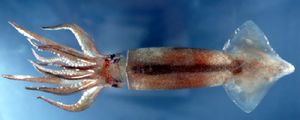Northern shortfin squid facts for kids
Quick facts for kids Northern shortfin squidIllex illecebrosus |
|
|---|---|
 |
|
| Dorsal view | |
 |
|
| Lateral view | |
| Conservation status | |
| Scientific classification | |
| Genus: |
Illex
|
| Species: |
illecebrosus
|
| Synonyms | |
|
|
The northern shortfin squid, also known as Illex illecebrosus, is a type of squid that lives in the ocean. These squids belong to a group called Ommastrephidae. You can find them in the northwest Atlantic Ocean. Their home ranges from the eastern coast of North America all the way to Greenland, Iceland, and even west of Ireland and the United Kingdom.
These squids are known for traveling long distances. They don't live very long, usually less than a year. People catch a lot of northern shortfin squid for food, especially in the United States and Canada. Most of these squids are sold in Canada and Japan. They are a very important part of the ocean's ecosystem and a valuable resource for fishing.
Contents
What Do They Look Like?
The northern shortfin squid is a medium-sized squid. Female squids are usually between 20 to 30 centimeters (about 8 to 12 inches) long. Males are a bit smaller, typically 18 to 27 centimeters (about 7 to 11 inches) long. This measurement is taken from their mantle, which is the main part of their body.
These squids have short tentacles and a long, narrow head. Their head is connected to their long mantle. The fins on their body are shorter along the mantle but are about twice as long when measured across. Northern shortfin squids are usually reddish-brown to purple. Their head and mantle are darker, while the rest of their body has a yellowish-green tint.
Where Do They Live and Travel?
Northern shortfin squids are amazing travelers! They migrate from colder northern waters to warmer subtropical areas. They can travel as far as 1,000 miles. These squids move a lot throughout the year, depending on the season.
Their range stretches from about 66°N (north) to 29°N (north). This means they can be found from central Florida up to Newfoundland and Labrador. They live in both the open ocean and closer to the coast. You can find a lot of these squids near Newfoundland and New Jersey.
What Do They Eat?
Northern shortfin squids mainly eat fish and small crustaceans, like shrimp or crabs. When they are young, they eat more crustaceans. As they grow bigger, their diet changes to mostly fish. They usually hunt and eat at night, near the surface of the water.
Like some other squid species, larger northern shortfin squids might sometimes eat smaller squids. Studies have shown that the squids caught in Newfoundland in 1979 often ate fish that are also important for human fishing. They eat many kinds of fish, including Atlantic cod, hake, and capelin. Scientists can tell what they've eaten by finding fish ear bones (called otoliths) in their stomachs.
Reproduction and Life Cycle
Northern shortfin squids can lay eggs all year round. However, squids that hatch in the winter often have a better chance of surviving. This is because the conditions are just right for them to grow well. Good growth helps them make their spawning migration later.
Most squids hatch between June and December. The busiest hatching months are July, August, September, October, and November. Interestingly, being male or female doesn't change how fast their total body weight grows. But the month they hatch does affect their growth rate. Female squids generally grow faster than males. Their growth in mantle length increases steadily.
However, the place where they live also affects their growth. In the waters off Newfoundland and Nova Scotia, male squids actually grow faster than females. Young squids are usually 34 to 66 millimeters (about 1.3 to 2.6 inches) long. Adults can reach up to 35 centimeters (about 14 inches). Squids living in warmer waters, especially in the Mid-Atlantic region, tend to grow more quickly.
Who Eats Them?
Northern shortfin squids have developed clever ways to protect themselves from predators. They can squirt ink to confuse attackers, swim together in large groups (schooling), and change their color to blend in with their surroundings (camouflaging).
Many larger ocean animals hunt northern shortfin squids. These include big fish like Atlantic bluefin tuna, red hake, and silver hake. Marine mammals also prey on them, such as pilot whales and dolphins.



